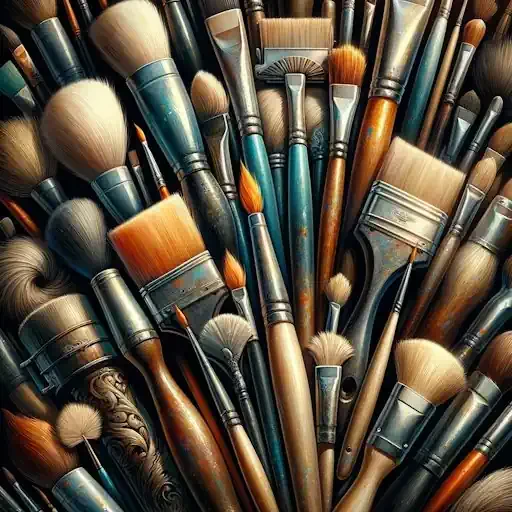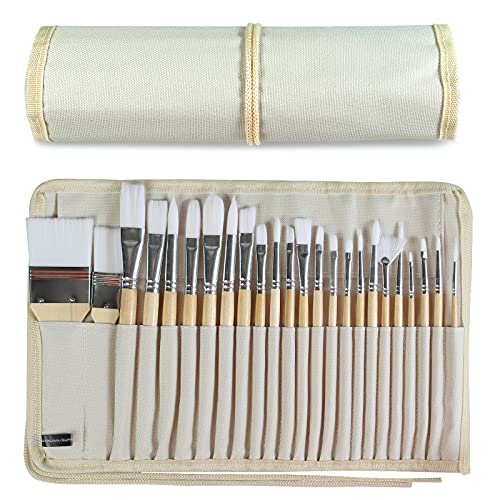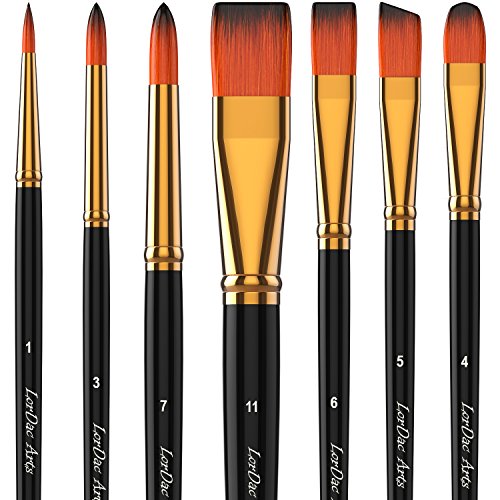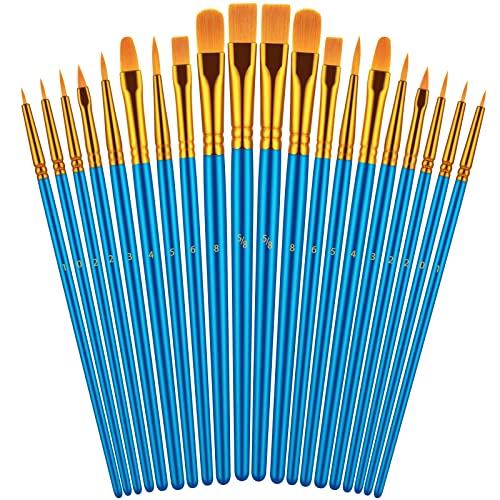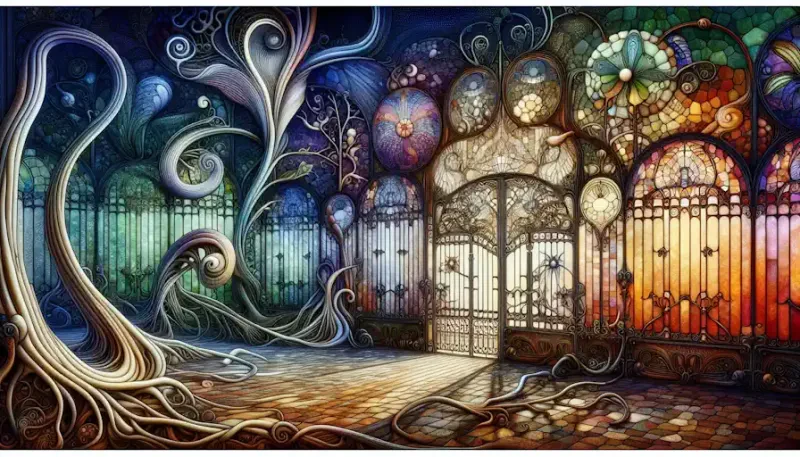Introduction
Art is a tapestry woven with strokes of imagination, passion, and skill, and at its core lies the paintbrush—a conduit for translating creative vision onto canvas. Yet, choosing the right paintbrush is not merely a practical decision; it is an intimate exploration of one's artistic identity and expression. In this definitive guide, we embark on a journey through the intricate world of paintbrush selection, delving deep into the anatomy, materials, types, and considerations that define each brush. By the journey's end, you will possess not only the knowledge but also the intuition to select the perfect brushes, ones that resonate with your artistic voice and elevate your creations to new heights of beauty and depth.
Understanding Paintbrush Anatomy
Handle
Material: The handle serves as the brush's backbone, determining its durability, comfort, and aesthetics. Wooden handles offer a classic appeal, with varying wood types providing different textures and weights. Acrylic handles, sleek and modern, prioritize durability and easy maintenance. Metal handles, though less common, exude an industrial elegance and are often favored for their longevity.
Shape: The shape of the handle is not merely cosmetic but plays a crucial role in ergonomics and comfort during extended use. Whether cylindrical, tapered, or contoured, the handle should fit snugly in the artist's hand, providing balance and control.
Length: The length of the handle influences the artist's posture, reach, and maneuverability. Longer handles offer better leverage for large, sweeping strokes, while shorter handles provide greater precision and control for detail work.
Ferrule
Material: The ferrule, typically made of nickel, aluminum, or brass, secures the bristles to the handle and protects them from damage. Brass ferrules are favored for their corrosion resistance and malleability, ensuring a tight grip on the bristles.
Construction: The construction of the ferrule—whether crimped, welded, or seamless—affects its strength and durability. Double-crimped ferrules provide extra reinforcement, preventing bristle shedding and prolonging the brush's lifespan.
Fit: A well-fitted ferrule should encase the bristles securely without gaps or looseness, ensuring a stable connection between the bristles and the handle.
Bristles
Types: Bristles are the soul of the paintbrush, dictating its performance, versatility, and texture. Natural bristles, sourced from animals like sable, hog, and squirrel, offer unique qualities such as softness, resilience, and absorbency. Synthetic bristles, crafted from materials like nylon, taklon, and polyester, provide durability, versatility, and affordability.
Shape: The shape of the bristles determines the brush's versatility and application. Round brushes, with their tapered tips, are versatile for both fine details and broad strokes. Flat brushes, with their straight edges, excel in covering large areas and creating sharp lines. Filbert brushes, with their rounded tips, offer a blend of precision and softness, ideal for blending and shading.
Types of Paintbrushes
Round Brushes
Subtypes: Round brushes come in various subtypes tailored to different painting techniques and styles. Pointed round brushes are ideal for intricate details and precise linework, while standard round brushes offer versatility for both fine details and broader strokes. Stubby round brushes provide greater control for heavier applications and thicker paint.
Best Uses: Round brushes are versatile tools suitable for various painting styles, from detailed work to expressive brushstrokes. They excel in creating curves, contours, and intricate patterns, making them essential for figurative, floral, and decorative painting.
Flat Brushes
Subtypes: Flat brushes, with their broad, straight edges, are indispensable for covering large areas and creating crisp, defined lines. Bright brushes, with shorter bristles, are perfect for short, controlled strokes, while one-stroke brushes excel in covering large areas with ease.
Best Uses: Flat brushes are ideal for painting architectural elements, landscapes, and geometric shapes, as well as for achieving smooth gradients and blending colors. They provide versatility for both broad washes and fine details, making them essential for both beginners and experienced artists.
Filbert Brushes
Subtypes: Filbert brushes, with their rounded tips and flat sides, offer a versatile blend of precision and softness. Standard filbert brushes provide balanced performance for various techniques, while long filbert brushes offer expressive strokes and short filbert brushes provide precision for detailed work.
Best Uses: Filbert brushes are ideal for blending, shading, and creating organic shapes in portraits, still lifes, and landscapes. They excel in softening edges, creating subtle transitions, and adding depth and dimension to paintings, making them indispensable for artists seeking versatility and control.
Fan Brushes
Subtypes: Fan brushes, with their spread-out bristles arranged in a fan shape, are versatile tools for creating texture, blending colors, and adding atmospheric details to paintings. Natural hair fan brushes offer soft, delicate textures and subtle transitions, while synthetic fan brushes provide stiffness and control for precise effects.
Best Uses: Fan brushes are perfect for creating foliage, grasses, clouds, and other natural textures in landscapes and seascapes. They excel in adding movement, depth, and atmosphere to paintings, making them essential for artists seeking to capture the essence of nature and environment.
Detail Brushes
Subtypes: Detail brushes cater to fine, intricate work and precise detailing. Liner brushes are perfect for fine lines, calligraphy, and intricate patterns, while spotter brushes excel in precise dotting and stippling. Rigger brushes are ideal for continuous lines, curves, and long strokes.
Best Uses: Detail brushes are essential for adding final touches, highlights, and fine details to paintings. They excel in creating textures, patterns, and intricate designs, making them indispensable for artists seeking precision and refinement in their work.
Bristle Materials
Natural Bristles
Hog Hair: Hog hair brushes are prized for their stiffness, durability, and paint-carrying capacity, making them ideal for oil and acrylic painting. They provide excellent control and texture, allowing artists to create expressive brushstrokes and impasto effects.
Sable Hair: Sable hair brushes offer exceptional softness, spring, and water retention, making them ideal for watercolor painting. They provide smooth, flowing brushstrokes and precise control, allowing artists to achieve delicate washes and vibrant color blends.
Squirrel Hair: Squirrel hair brushes are renowned for their ultra-soft texture, absorbency, and fluidity, making them ideal for watercolor and gouache painting. They hold a generous amount of water and pigment, allowing artists to create seamless washes and subtle transitions with ease.
Best Uses: Natural bristle brushes offer unique qualities suited to specific painting mediums and techniques. They excel in providing texture, fluidity, and control, enhancing the expressive potential of each brushstroke.
Synthetic Bristles
Nylon: Nylon brushes are known for their durability, versatility, and affordability, making them suitable for a wide range of mediums and techniques. They provide consistent performance and resilience, maintaining their shape and springiness over time.
Taklon: Taklon brushes mimic the softness and resilience of natural hair, making them ideal for water-based paints such as acrylics and gouache. They offer excellent color retention and precision, allowing artists to achieve fine details and smooth, even coverage.
Polyester: Polyester brushes are valued for their stiffness, durability, and ability to withstand heavy-bodied paints and solvents. They provide excellent control and coverage, making them ideal for impasto techniques, texture painting, and mixed media applications.
Best Uses: Synthetic bristle brushes offer durability, resilience, and affordability, making them suitable for various painting styles and techniques. They provide consistent performance and easy maintenance, making them ideal for both beginners and experienced artists.
Considerations for Different Mediums
Oil Painting
Brush Resilience: Oil paints demand brushes with resilient bristles that can withstand the heavy application and manipulation inherent to the medium. Natural bristle brushes, particularly those made from hog hair, excel in oil painting due to their stiffness, durability, and paint-carrying capacity.
Bristle Stiffness: Oil paints require brushes with stiffer bristles to manipulate the thick, viscous paint and create expressive brushstrokes and impasto effects. Brushes with long, firm bristles provide better control and texture, allowing artists to build up layers and add intricate details to their paintings.
Best Practices: When painting with oils, use brushes with firm, resilient bristles and long handles for maximum control and maneuverability. Clean brushes thoroughly with solvent or oil-based cleaners to remove paint residues and maintain bristle integrity.
Acrylic Painting
Brush Cleanability: Acrylic paints dry quickly and are water-soluble when wet, making them easy to clean from brushes with warm water and mild soap. Synthetic brushes, such as those made from nylon or taklon, are ideal for acrylic painting due to their resilience and ease of cleaning.
Bristle Spring: Acrylic paints require brushes with good spring and resilience to maintain shape and control during application. Synthetic brushes offer excellent springiness and snap, allowing artists to create crisp edges, fine details, and expressive brushstrokes with ease.
Best Practices: When painting with acrylics, use synthetic brushes with durable, resilient bristles and short handles for precise control and maneuverability. Clean brushes promptly after each painting session to prevent acrylic paint from drying and hardening on the bristles.
Watercolor Painting
Bristle Absorbency: Watercolor paints are water-based and transparent, requiring brushes with highly absorbent bristles that can hold large amounts of water and pigment. Natural hair brushes, particularly those made from sable or squirrel hair, are preferred for watercolor painting due to their exceptional water retention and fluidity.
Brush Precision: Watercolor painting often involves delicate washes, fine details, and controlled blending, necessitating brushes with fine points and tapered edges. Natural hair brushes offer superior precision and control, allowing artists to achieve smooth gradients, subtle transitions, and intricate textures in their watercolor paintings.
Best Practices: When painting with watercolors, use natural hair brushes with fine, resilient bristles and long handles for maximum water retention and control. Clean brushes thoroughly with water and mild soap after each use to remove pigment residues and maintain bristle softness.
Gouache Painting
Bristle Softness: Gouache paints have a creamy consistency and opaque coverage, requiring brushes with soft, flexible bristles that can handle the paint's thickness while maintaining precision and control. Synthetic brushes, such as those made from taklon or nylon, are well-suited for gouache painting due to their resilience and versatility.
Brush Versatility: Gouache painting often involves layering, blending, and fine detailing, necessitating brushes that can handle both delicate washes and opaque layers. Brushes with medium-sized, round or filbert-shaped heads offer a balance of precision and coverage, allowing artists to create diverse effects and textures in their gouache paintings.
Best Practices: When painting with gouache, use synthetic brushes with soft, flexible bristles and medium-sized heads for versatile application and control. Clean brushes promptly after each use to prevent paint residues from drying and hardening on the bristles.
Other Specialized Mediums
Ink Painting: Ink painting requires brushes with fine, flexible bristles that can hold a sharp point and deliver consistent, controlled lines. Synthetic brushes, such as those made from nylon or taklon, are suitable for ink painting due to their precision and durability.
Enamel Painting: Enamel paints are known for their vibrant colors and glossy finish, requiring brushes with heat-resistant bristles that can withstand the high temperatures of firing and curing. Natural bristle brushes, particularly those made from hog hair or ox hair, are ideal for enamel painting due to their resilience and durability.
Best Practices: When working with specialized mediums like ink or enamel, choose brushes specifically designed for the medium to ensure optimal performance and durability. Clean brushes thoroughly after each use to prevent pigment or paint residues from affecting future applications.
Size and Shape Selection
Scale Consideration
Large Brushes: Large brushes are ideal for covering large areas quickly and laying down bold strokes with ease. They are well-suited for painting backgrounds, blocking in shapes, and applying base coats.
Small Brushes: Small brushes are perfect for fine details, intricate patterns, and precise linework. They are essential for adding highlights, refining edges, and adding texture to paintings.
Best Practices: Consider the scale and proportion of your artwork when selecting brush sizes. Use larger brushes for broad areas and smaller brushes for details and fine lines, ensuring a balanced composition and visual harmony.
Shape Variation
Round Brushes: Round brushes are versatile tools that can create both broad strokes and fine details with ease. They are ideal for painting subjects with rounded forms, such as flowers, fruits, and figures, and can be used for everything from underpainting to final details.
Flat Brushes: Flat brushes are excellent for creating crisp edges, broad washes, and defined shapes. They are ideal for painting architectural elements, geometric shapes, and landscapes, as well as for achieving smooth gradients and blending colors.
Best Practices: Experiment with different brush shapes to discover their unique capabilities and effects. Combine round, flat, and filbert brushes to achieve a variety of textures, shapes, and brushstrokes in your artwork.
Quality vs. Price
Quality Indicators
Bristle Integrity: High-quality brushes feature tightly packed bristles and well-secured ferrules that prevent shedding and ensure durability. Look for brushes with uniform bristle length, consistent shape, and smooth, even edges.
Handle Construction: Quality brushes have well-balanced handles with smooth finishes and ergonomic designs that provide comfort and control during painting. Choose brushes with durable materials, such as hardwood or acrylic, and seamless ferrule attachment for maximum durability and longevity.
Best Practices: Invest in high-quality brushes made from premium materials to ensure optimal performance and longevity. Consider factors such as bristle integrity, handle construction, and overall craftsmanship when selecting brushes for your artistic endeavors.
Price Considerations
Budget-Friendly Options: Affordable brushes can provide decent performance and durability for beginners or hobbyists on a budget. Look for brushes with synthetic bristles and plastic handles that offer good value for money without compromising on quality.
Investment-Worthy Brushes: High-quality brushes may come with a higher price tag, but they offer superior performance, longevity, and artistic satisfaction. Consider investing in brushes made from premium materials, such as natural hair and hardwood, that will elevate your artwork and stand the test of time.
Best Practices: Strike a balance between quality and price when selecting brushes, considering factors such as your budget, painting style, and frequency of use. Invest in a few high-quality brushes for essential tasks and supplement them with budget-friendly options for less demanding applications.
Caring for Your Brushes
Cleaning Techniques
Gentle Cleaning: Clean brushes promptly after each painting session to prevent paint from drying and hardening on the bristles. Use lukewarm water and a mild soap or brush cleaner to remove paint residues and rinse thoroughly until the water runs clear.
Conditioning: Periodically condition natural hair brushes with brush soap, hair conditioner, or specialty brush oils to keep the bristles soft, supple, and free from fraying or brittleness.
Best Practices: Develop a regular cleaning routine for your brushes, incorporating gentle cleaning techniques and conditioning treatments to prolong their lifespan and maintain optimal performance.
Storage Tips
Proper Drying: After cleaning, reshape the bristles and allow brushes to air dry thoroughly before storing them. Store brushes upright in a brush holder or container with the bristles facing upward to prevent deformation and maintain their shape.
Protective Measures: Store brushes in a dry, well-ventilated area away from direct sunlight, heat sources, and humidity to prevent mold, mildew, and damage to the bristles. Avoid overcrowding brushes or storing them in sealed containers, as this can lead to deformation and bristle damage.
Best Practices: Invest in proper brush storage solutions, such as brush holders or racks, to keep your brushes organized and easily accessible. Avoid storing brushes in cramped or damp environments that may compromise their quality and longevity.
Maintenance Practices
Regular Inspection: Periodically inspect brushes for signs of wear and damage, such as loose ferrules, bent bristles, or splintering handles. Address any issues promptly by reattaching loose ferrules, trimming stray bristles, or sanding rough edges to prolong the lifespan of your brushes.
Rotation: Rotate brushes regularly to distribute wear evenly and prevent excessive strain on individual brushes. Use different brushes for different painting techniques and mediums to extend their longevity and versatility.
Best Practices: Develop a habit of regularly inspecting and maintaining your brushes to ensure optimal performance and longevity. Address any issues promptly and rotate brushes to distribute wear evenly, extending their lifespan and preserving their quality over time.
Experimentation and Personal Preference
Artistic Exploration
Creative Freedom: Embrace experimentation and exploration as essential aspects of your artistic journey. Try out different brushes, techniques, and mediums to discover your unique style, voice, and visual language.
Playful Spirit: Approach painting with a sense of curiosity, wonder, and playfulness, allowing yourself to make mistakes, take risks, and learn from the process. Let go of expectations and preconceived notions, and allow your intuition and imagination to guide you on a journey of self-discovery and artistic growth.
Best Practices: Foster a spirit of creativity and experimentation in your artistic practice, allowing yourself the freedom to explore new techniques, materials, and subjects. Embrace the process of discovery and embrace the joy of creating, trusting your instincts and intuition to lead you toward new artistic horizons.
Intuitive Selection
Trusting Instincts: Listen to your instincts and intuition when selecting brushes, trusting your gut feelings and personal preferences over external advice or trends. Choose brushes that feel comfortable, responsive, and intuitive to you, resonating with your unique artistic sensibilities and creative vision.
Emotional Connection: Develop a deep, personal connection with your brushes, treating them not just as tools but as extensions of your creativity, passion, and identity. Cultivate a sense of reverence and respect for your brushes, acknowledging their role in bringing your artistic visions to life and honoring the symbiotic relationship between artist and instrument.
Best Practices: Cultivate a mindful approach to brush selection, paying attention to how each brush feels in your hand and how it responds to your touch. Trust your intuition and emotional connection to guide you toward brushes that resonate with your artistic voice and enhance your creative process.
Conclusion Choosing Artistic Paint Brushes
In the grand tapestry of artistry, the paintbrush emerges as a potent symbol of creativity, expression, and boundless potential. Through the careful selection of brushes—each stroke deliberate, each choice imbued with intention—you breathe life into your creations, infusing them with depth, emotion, and meaning. May this guide serve as a compass on your artistic journey, guiding you through the vast expanse of paintbrush possibilities and empowering you to craft works that resonate with authenticity, beauty, and soul. For in the end, it is not merely the brush that paints the masterpiece, but the hand that wields it and the heart that guides it toward the timeless pursuit of truth, beauty, and self-expression.
